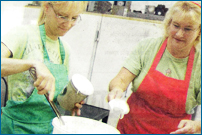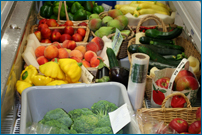Long before a cone or cup of ice cream is put in a customer’s hands, it begins its journey in the new kitchen at Tulmeadow Farm. Five years in the making, the bright, spacious kitchen is a far cry from the dark, cramped room where the farm’s famous ice cream was previously made.
Located down a hallway off of the farm store, past several large freezers, the new kitchen is set up for two purposes. On one end is the section where ice cream is made, complete with shelves of supplies including chocolate chunks, Oreo cookies and base mixtures for a variety of flavors. Freezers are lined up on one wall and a large ice cream machine is set up along another wall.

Cindy Bursiewicz and her cousin Carolyn Poitras hand packing Tulmeadow Ice Cream.
Wheeled carts are parked here and there to transport tubs and ingredients around the room. There are also large commercial sinks and plenty of space for the quart-filling machine, although that has not been set up yet. For now, pints and quarts are packed by hand.
At the other end of the room is a commercial kitchen for baking. Here Beverly Tuller concocts her baked goods, sold under the name of Bevalicious in the farm store.
“The goal is to achieve some production efficiency,” said Don Tuller, who operates the farm with his cousin, Buzz Tuller. “The whole thing is the convergence of systems that complement each other.”
Don Tuller has a B.S. degree in Animal Science and always had an interest in natural systems.
Prior to the new kitchen becoming operational, those making ice cream shared space with those serving the frozen treat, creating a crowded, inefficient area for all. Two air conditioners were needed to keep the old space cool and there was little room to store supplies that were spread out on shelves all over the building.
The new kitchen is 20-by-32 square feet, whereas the former manufacturing and serving area was 20-by-20.

Part of the new baking center at Tulmeadow Farm.
The new space makes it easier to retrieve ice cream from the large storage freezers in the hall and bring it to the serving area. Before, workers had to go outside and walk around to another part of the building to get more tubs of the frozen dessert.
With everything in one place, it’s a snap to make 10 batches a day.
One warm day, Cindy Bursiewicz and her cousin Carolyn Poitras were in the kitchen whipping up batches of chocolate chip, chocolate chocolate chip and Oreo cookie ice cream. The farm was just coming off a hot holiday weekend and the supply needed to be replenished.
Both women agreed they were enjoying the new space.
Tuller will typically leave workers a list of the flavors that are in short supply. He described the process as being similar to ice cream made ,at home. A big difference is the scale of the operation.
“ Carolyn and Cindy keep an eye on it. You develop a practiced eye on the right consistency,” he said.
Poitras emptied a large bag of cream and milk into the machine, in addition to any other necessary flavorings. Minutes later she pulled up a stool to sit on while she held the coritainer, as the now-frozen mixture pooled into one of the containers
that Bursiewicz had just finished folding together.
Poitras mixed in, by hand, any of the “chunks,” including large chocolate bits, Oreo cookies or M&Ms, and Bursiewicz put lids on the containers and labels before placing them in the nearby freezers. The two had the system down and quickly finished one batch and moved on to the next flavor.
Poitras said that, typically, the number of batches they make are # fewer than on this day, but “ now that ice cream season is kicking into gear,” they will be busy.
She is fan of peppermint stick while Bursiewicz likes birthday cake. Both agreed that, while they enjoy ice cream, they can’t eat it everyday.
As Poitras leveled off the frozen concoction with a spatula, she explained that fruit flavors tend to be a fluffier consistency and more gallons can be made compared to non-fruit flavors.
It was on August 19, 1994 that Tulmeadow Farm served its first scoops of ice cream. Prior to that. it operated as a dairy farm, beginning in the 1950s.
The farm had an important decision to make. The cost of maintaining a milking herd had to balanced with the loss of profitability. The owners decided that in order to keep the farm that has been operating as such since 1768 alive, it would be best to transition out of the dairy business.
The operation then became more retail oriented. With the installation of greenhouses, plants and vegetables were grown and a roadside stand was set up to sell the products. That stand would develop into the current farm store.

One stocked cooler with freshly picked fruits and vegetables in the FarmStore.
Through the years, the store has added products and now carries a selection of Tulmeadow-grown plants, vegetables and food, as well as other items from producers in the area. There is honey from Farmington, maple syrup from Burlington, bread from the Collinsville Baking Company and more.
“ The idea was to have the whole meal right here,” Tuller said, adding that anything that is not grown directly on the farm is supplemented by other farms in the area.
Over time, the dairy cows that once roamed the fields became beef cattle and meat is also sold in the store. Today, the farm has about 60 head of grass-fed cattle.
Tuller said that in the 1990s, the farm began to think of how it could become more of a destination location and the idea of ice cream was considered. Connecticut-based Guida Dairy provides the sweetened milk and cream base used to make Tulmeadow ice cream.
“ It took us 20 years to build up the business,” Tuller said.
Today, Tulmeadow offers 50 flavors of ice cream. When the crowds show up depends on the weather. If it’s too hot, folks will not come out for ice cream. If it’s raining, they may not want to wait outside.
“Ice cream is kind of a fair weather product,” said Tuller.

New freezers are stocked for ice cream delivery and Tulmeadows Ice Cream windows.
Tulmeadow ice cream can also be purchased fit Kane’s Market and Fitzgerald’s Foods and other stores in the area, including Whole Foods Market in Glastonbury.
This year, the farm opened for the season in March, earlier than it has in the past, due to the warmer than normal weather in the early spring. Typically, the farm store opens in mid-April.
“We are certainly ahead of last year in terms of sales,” Tuller said, adding that it’s a long season and there’s no telling what the summer will bring.
The early warm weather had an impact in other areas of the business, too, including sweet corn. He predicts that the com will be ready much sooner than in previous years.
As a way to extend the retail season, Tulmeadow sells mums in the fall and Christmas trees and wreaths in December.

A field of tomatoes ready to ripen for late summer.
The farm has undergone the long process of selling its development rights to the Simsbury Land Trust, thus ensuring that the property will remain a farm in perpetuity. It was an eight-year process. More recently, the Tulmeadow Woodlot was acquired and is now available to the public for hiking.
“I just decided early on I was more committed to the farm than a certain type of agriculture,” Tuller said.
“As we looked at the reality of the dairy side of the business, if I was committed today, I would have been, more in favor of selling. Had we expanded the dairy, we would have been out of business. The ice cream has done what we hoped it would do, make us more of a destination.”
He added “the other part of it, we’ve been lucky. The setting is nice, [and] we’ve had plenty of publicity.”
Tuller’s daughter works on the farm, as do some of his nieces and nephews. Whether or not other family members will one day take over the operation remains to be seen.
“The goal with doing the land trust was to keep a farm here”, Tuller said.
The article above appeared in the July 2012 Simsbury Life Newspaper and is by Alicia B. Smith
